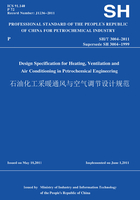
4 Ventilation
4.1 General Requirements
4.1.1 For the petrochemical production plants in which the harmful and explosion hazardous substances emit,comprehensive safety protection and pollution control measures shall be taken in the designs in terms of process,plot-plan,architecture,equipment,ventilation,etc..
4.1.2 The tightness,isolation and negative pressure operation measures of production plant that probably diffuses and leaks harmful substances shall be strengthened,and operations of mechanization and automation should be used.The production process with highly toxic substances shall be performed under the operation conditions of tightness or negative pressure,and automation or blocked operation shall be used.
4.1.3 The production plants that diffuse the explosion-hazardous substances shall be installed in the open air.When they have to be installed in plant buildings,the open-type or semi-open type buildings shall be used.
4.1.4 The layout of plant buildings and production processes that emit heat or harmful substances shall comply with the following requirements:
a)The production processes emitting extremely toxic,highly toxic and relatively toxic substances laid out in a same building shall be blocked.
b)The operation and maintenance zones shall be defined calearly,and the operation zone should be set out nearby the exterior windows.
c)Multi-span production buildings shall be avoided.
d)In the multi-storey buildings,the production processes which emit heat and harmful gases,shall be arranged on the upper floors.When it is necessary to arrange them on the lower floors,the measures to protect the air of the upper storeys from contamining shall be taken.
e)For the plant buildings with the natural ventilation,the emitting sources of heat and harmful substances shall be arranged under the scuttles or nearby the exhaust outlet.
Notes:1 The extremely toxic substance refer to the substance which the maximum permissible concentration of harmful substances in the air of production buildings is smaller than 0.1mg/m3,e.g.lead tetraethyl,trinitrotoluene,organic phosphorus,etc..
2 The highly toxic substance refer to the substance which the maximum permissible concentration of harm substances in the air of production buildings is 0.1mg/m3-1mg/m3,e.g.chlorine,phenyl hydrate,acrylonitrile,etc..
3 The relatively toxic substance refer to the substance which the maximum permissible concentration of harmful substances in the air of production buildings is greater than 1mg/m3,e.g.acetonitrile,hydrogen chloride,nitrogen oxide,etc..
4.1.5 The production buildings with extremely toxic and highly toxic substances shall not be laid out in valleys,basins or on the leeward slopes at the annual maximum frequency of wind.
4.1.6 The control rooms and on-duty rooms for process units emitting harmful substances shall be located at the leeward side of wind direction with annual minimum frequency,the production buildings mainly relying on natural ventilation shall be arranged along wind direction favorable for natural ventilation in summer.
4.1.7 The concentration of harmful gases,vapor and dust in the air supplied to the production buildings through mechanical ventilation system shall not exceed 30% of the maximum permissible concentration of harmful substances.When it is exceeded,air shall be taken from the clean area,or the air purification devices shall be provided.
4.1.8 The content of harmful substances in the gas emitted to the atmosphere shall meet the requirements of GBZ 1,GB 3095,GB 16297,GB 8978,etc..When the requirements cannot be met,effective purification measures shall be taken.
4.1.9 For production buildings emitting heat,vapor or harmful substances,priority shall be given to local exhaust system,and if local exhaust system is unable to satisfy requirements,it shall be supported by general exhaust system or general exhaust system shall be used instead.
4.1.10 In designing local exhaust system or general exhaust system,priority shall be given to natural ventilation.If natural ventilation cannot meet the process requirements,it shall be supported by mechanical ventilation or combined natural and mechanical ventilation shall be used.
4.1.11 Production buildings emitting dust shall have appropriate dust collection facilities provided based on process characteristics and dust properties.
4.1.12 General ventilation rate may be determined according to one of the following methods:
a)General ventilation rate shall be calculated based on the quantities of harmful substances emitted in production buildings:
1)If harmful substances,excess heat and excess moisture are emitted simultaneously,the general ventilation rate shall be calculated based on the one with the largest ventilation air demand.
2)If several solvent vapors(benzene and its homologens,alcohols or acetic esters)or several irritating gases(sulfur trioxide and sulfur dioxide or hydrogen cyanide and its salts)are emitted simultaneously,the general ventilation rate shall be calculated based on the sum of the ventilation air required for diluting each kind of vapor or gas to the maximum allowable concentration.If other harmful substances are emitted simultaneously,the general ventilation rate shall be calculated based on the harmful substance with the largest ventilation air demand.
b)General ventilation rate shall be calculated based on the measured data for production buildings with same or similar process flows:
c)If it is impractical to determine the general ventilation rate according to Item a)or Item b),general ventilation rate may be determined by air change rates as given in Appendix B of this Specification,depending on factors such as the volume of production buildings,arrangement compactness of equipment,operational performance of equipment and the safety facilities provided.
4.1.13 Individual exhaust system shall be provided for any one of the following cases:
a)Combustion or explosion possibly occurs when two or more harmful substances are mixed.
b)More toxic or corrosive mixture or compound is possibly formed after mixing.
c)Steam is prone to condensing and dust is easily built up after mixing.
d)Rooms and equipments emitting highly toxic substances.
e)Rooms dedicated for storing flammable or explosive substances or rooms having fire-proof and explosion-proof requirements.